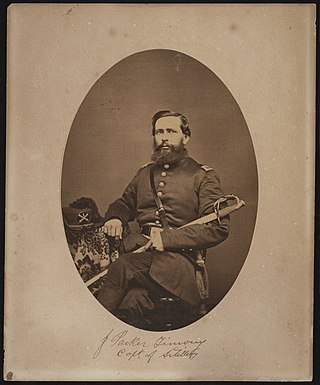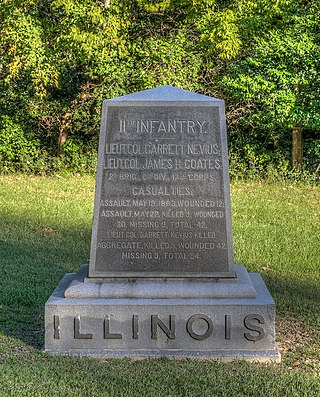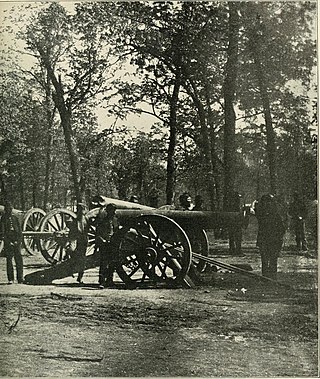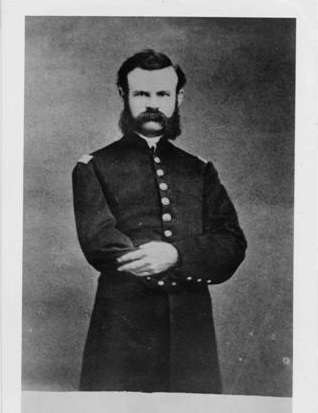See also
- List of Tennessee Civil War units
- Tennessee in the Civil War
- Battle of Fort Pillow
- 1st Regiment Alabama Siege Artillery (African Descent), aka 6th US Colored Heavy Artillery
| Memphis Battery Light Artillery (African Descent) | |
|---|---|
| Active | October 31, 1863 to March 11, 1864 |
| Country | United States |
| Allegiance | Union |
| Branch | artillery |
| Engagements | Battle of Fort Pillow (one section) Battle of Brice's Crossroads (one section) |
The Memphis Battery Light Artillery (African Descent) was an artillery battery that served in the Union Army during the American Civil War. The unit was also called 1st Tennessee Battery (African Descent).
The Memphis Battery Light Artillery (African Descent) was organized at Memphis, Tennessee and mustered in for three years on October 31, 1863 under the command of Captain Carl A. Lamberg. As was custom at the time, the battery was designated the Memphis Battery (Colored) Light Artillery. It was initially attached to the 1st Tennessee Heavy Artillery Regiment (African Descent) as Battery M.
The battery was attached to the garrison of Fort Pickering, District of Memphis, 5th Division, XVI Corps, Department of the Tennessee, to January 1864. 1st Colored Brigade, District of Memphis, Tennessee, XVI Corps, to April 1864.
The Memphis Battery Light Artillery (African Descent) ceased to exist on March 11, 1864 when its designation was changed to Battery D, 2nd United States Light Artillery Regiment (Colored). This designation was changed again on April 26, 1864 to Battery F, 2nd United States Colored Light Artillery.
During its brief existence, the regiment performed post and garrison duty at Memphis, Tennessee, until April 1864. One section under the command of Lieutenant A. M. Hunter was sent to Fort Pillow, Tennessee, on February 15, 1864. During the final assault on the fort, the section of 2nd U.S. Light Artillery (colored) manned two 6-pound James Rifles cannon in the center two embrasures of the fort. All Union artillery was largely ineffective because the guns could not be depressed enough to fire upon the Confederates on the steep terrain below. Nearly every man in this detachment was killed or missing in action when Maj. Gen. Nathan Bedford Forrest captured the fort on April 12, 1864 and Union troops were subsequently massacred.
In his report of April 27, 1864, Captain Lamberg, who was not present at the battle, stated that the section had one officer and 34 enlisted men. Of these, six were killed, four wounded, five taken prisoner, and Lieutenant Hunter and 18 other men were listed as missing in action. Private John Kennedy, who was wounded and captured (but escaped to report to Captain Lamberg), stated that he saw Lieutenant Hunter and several men of the section in the Mississippi River, but that he was captured before seeing what became of them.
Captain Lamberg commanded one section in June 1864 under Brig. Gen. Samuel D. Sturgis on his expedition into Mississippi. The expedition ended in defeat Maj. Gen. Forrest at the battle of Brice's Cross Roads. The section was attached to the brigade of Colonel W. L. McMillen and consisted of two officers and 37 enlisted men. The section's guns were spiked and abandoned on the field.
Records are incomplete, but the battery lost at least 6 men killed or mortally wounded during service.
The official report on the Battle of Fort Pillow identified only one soldier of the section of 40 men as a survivor. However, a review of individual service records identifies 8 survivors who were considered missing in action and 5 survivors who were released or paroled from prison camps. One reason for this oversight is that many soldiers of the 2nd US Colored Light Artillery were reported to be members of the 6th US Colored Heavy Artillery.
Many eyewitnesses stated that the officer in command of the section, Lieutenant Alexander M. Hunter, was killed. However, Lt. Hunter survived the battle and the war. (Source: "River Run Red")
One example of a survivor is Daniel Tyler who was shot in the eye and right shoulder. The Confederates threw him into the ditch and buried him in a mass grave. By dawn of the 13th, he managed to dig himself out. Tyler's story was told in many newspaper accounts. Though badly wounded and almost blind, he returned to his unit in May 1864. Then he left to recuperate from his wounds. When he returned in March 1865, he was accused of being absent without leave and was imprisoned in Irving Block Prison in Memphis. Amid the filth and deplorable conditions, he died in prison 4 months later on July 12, 1865. (Source: "River Run Red")

The Battle of Fort Pillow, also known as the Fort Pillow Massacre, was fought on April 12, 1864, at Fort Pillow on the Mississippi River in Henning, Tennessee, during the American Civil War. The battle ended with Confederate soldiers commanded by Major General Nathan Bedford Forrest massacring Union soldiers attempting to surrender. Military historian David J. Eicher concluded: "Fort Pillow marked one of the bleakest, saddest events of American military history."
The 1st Regiment Alabama Siege Artillery (African Descent) was an artillery regiment recruited from African-Americans that served in the Union Army during the American Civil War. The regiment was renamed the 6th US Colored Heavy Artillery. Under the leadership of Major Lionel Booth, the regiment fought at the Battle of Fort Pillow on April 12, 1864. The regiment then became the 7th US Colored Heavy Artillery, and later the 11th United States Colored Infantry.
4th Indiana Battery Light Artillery was an artillery battery that served in the Union Army during the American Civil War. It was often referred to as "Bush's Battery".
Battery I, 2nd Illinois Light Artillery Regiment was an artillery battery that served in the Union Army during the American Civil War.
The 1st Tennessee Heavy Artillery Regiment (African Descent) was an artillery regiment that served in the Union Army during the American Civil War.
Battery C, 1st Battalion Tennessee Light Artillery was an artillery battery that served in the Union Army during the American Civil War.

Battery D, 2nd Illinois Light Artillery Regiment, was an artillery battery that served in the Union Army during the American Civil War.
Battery E, 2nd Illinois Light Artillery Regiment, was an artillery battery that served in the Union Army during the American Civil War.
3rd Indiana Battery Light Artillery was an artillery battery that served in the Union Army during the American Civil War.

6th Indiana Battery Light Artillery was an artillery battery that served in the Union Army during the American Civil War.
9th Indiana Battery Light Artillery was an artillery battery that served in the Union Army during the American Civil War.
14th Indiana Battery Light Artillery was an artillery battery that served in the Union Army during the American Civil War.
Battery F, 1st Illinois Light Artillery Regiment, was an artillery battery that served in the Union Army during the American Civil War. The battery was also known as Cheney's Battery and Burton's Battery.
Battery G, 1st Illinois Light Artillery Regiment, was an artillery battery that served in the Union Army during the American Civil War. The battery was also known as O'Leary's Battery and Rombauer's Battery.

The 11th Regiment Illinois Volunteer Infantry was an infantry regiment from Illinois that served in the Union Army during the American Civil War. In April 1861, it was formed as a three-month volunteer unit, and in July 1861 it was reorganized as a three-year unit, in which role it served until the end of the war. Two of its commanding officers were promoted to brigadier general and led major units during the war. In its first major action at Fort Donelson the regiment suffered terrible losses. The 11th Illinois also fought at Shiloh, Riggins Hill, Vicksburg, First Yazoo City, Second Yazoo City, and Fort Blakely. In April 1863, the 109th Illinois Infantry Regiment was disbanded and its enlisted men transferred into the 11th Illinois. The regiment was mustered out of service in July 1865.

Cogswell's Battery Illinois Light Artillery was an artillery battery from Illinois that served in the Union Army during the American Civil War. Organized in November 1861 as Company A, 53rd Illinois Infantry Regiment, it was detached as an independent artillery battery in March 1862. The battery participated in the Siege of Corinth in May 1862. The unit remained near Memphis, Tennessee until June 1863 when it was ordered to reinforce the Siege of Vicksburg. Cogswell's Battery took part in the Jackson Expedition, the Missionary Ridge and in the Knoxville campaign in 1863. After performing garrison duty for most of 1864, the unit fought at Nashville in December. In spring 1865, the battery fought at Spanish Fort and Fort Blakeley during operations against Mobile, Alabama. The battery was mustered out in August 1865.

Battery I, 1st Illinois Light Artillery Regiment was an artillery battery from Illinois that served in the Union Army during the American Civil War. The battery was organized in February 1862 at Chicago and within two months it fought at Shiloh. Later, the battery served at Corinth, Vicksburg, Jackson, Missionary Ridge, Knoxville, Franklin, and Nashville. The battery mustered out of Federal service in July 1865.

Battery B, 2nd Illinois Light Artillery Regiment was an artillery battery from Illinois that served in the Union Army during the American Civil War. The battery was organized in June 1861. It fought at Shiloh, First Corinth, and Second Corinth in 1862. Subsequently, the unit garrisoned Corinth, Mississippi, until January 1864. It was stationed at Memphis, Tennessee, until June 1864 when it fought at Brices Cross Roads. The battery garrisoned Memphis until it was mustered out in July 1865.

Battery F, 2nd Illinois Light Artillery Regiment was an artillery battery from Illinois that served in the Union Army during the American Civil War. The battery was organized in December 1861 at Cape Girardeau, Missouri. The unit fought at Shiloh, First Corinth, and Second Corinth in 1862 and at Vicksburg and Jackson in 1863. The battery served in the Atlanta campaign and at Nashville in 1864. It was mustered out of federal service in July 1865. The battery's first commander was John Wesley Powell who later led an exploration of the Grand Canyon.

The 3rd United States Colored Cavalry was a regiment in the United States Army organized as one of the units of the United States Colored Troops during the American Civil War. The regiment was originally formed in October 1863 at Vicksburg, Mississippi as the 1st Mississippi Cavalry Regiment. The unit soon began taking part in expeditions near Vicksburg. In February–March 1864, the regiment saw action at Yazoo City. After being renamed the 3rd U.S. Colored Cavalry in March 1864, the regiment continued to participate in raids, including the Yazoo City expedition in May. In December 1864, the unit took part in a successful raid led by Benjamin Grierson during which the Battle of Egypt Station and other actions were fought. The regiment operated near Memphis, Tennessee, until April 1865, after which it returned to Vicksburg for occupation duties. The soldiers were mustered out of federal service in January 1866.